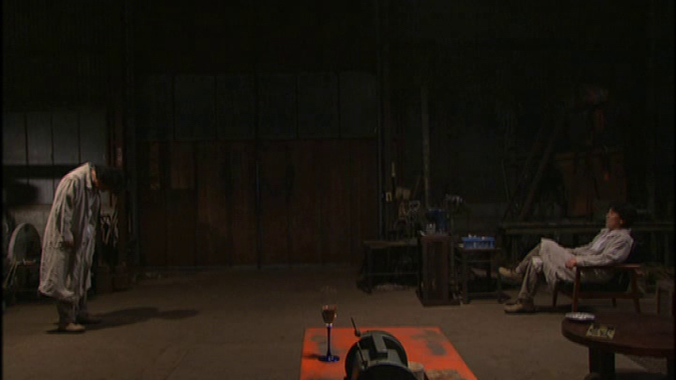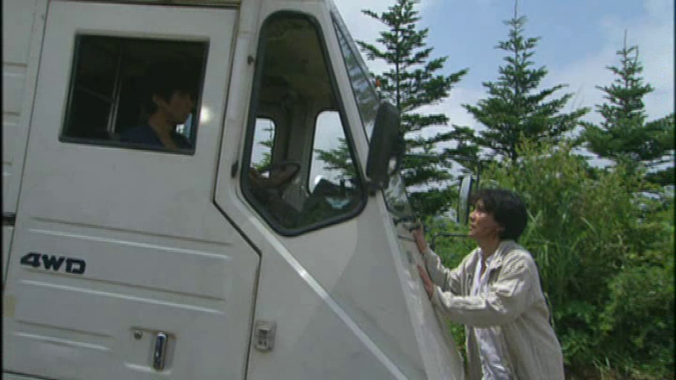 Japanese movies have a long tradition of starting in one direction and then suddenly changing tone to go a completely unexpected way, but rarely have they taken the turns to be found in Kiyoshi Kurosawa’s Doppelganger.
Japanese movies have a long tradition of starting in one direction and then suddenly changing tone to go a completely unexpected way, but rarely have they taken the turns to be found in Kiyoshi Kurosawa’s Doppelganger.
The doppelganger, of course, has long been a subject of horror stories and films, usually in the manner of Jekyll and Hyde, with an “evil twin” side of the hero suddenly released, or occasionally like Poe’s “William Wilson,” in which the doppelganger is the “good twin” who subverts the principal’s more perverted schemes.
Kurosawa’s film begins with both versions. Takashi is a slacker, as his sister describes him, living off his sister and watching TV all day. He suddenly commits suicide, soon replaced by a new Takashi who is the essence of a hard-worker, spending hours daily writing the novel he has always claimed he wanted to write and then finding his own apartment. The main story, however, quickly moves to Hayasaki (Koji Yakusho), an intensely focused “genius” trying to complete a chair for quadriplegics that can be operated by thought commands. He begins to see a person who looks like him out of the corner of his eye until at last the doppelganger appears and talks to him in a cafe and then inside his apartment. As the project continues to have problems with engineering and financing, the other Hayasaki says he will help, eventually getting him fired but then finding money, a new assistant, and a warehouse for him to work in. Soon he has perfected the chair and decides to sell it to a rival company, beginning a long road trip to Niigata across the mountains.
By that point, it has turned into a caper film in which Hayasaki is pursued across the mountains by the other Hayasaki, the assistant who now wants all the credit and money, and his old boss, who is also after the same things. Hayasaki at this point is accompanied by Yuka, Takashi’s sister, whom he first met when he heard about her experience with her doppelganger brother; she has fallen in love with one of the Hayasakis, though she is not quite sure which one she is dealing with at any time. The chase turns increasingly comic as people start getting killed in a series of pratfall deaths and coming back to life, magically reappearing far from where last seen.
It is not as simple as a Jekyll and Hyde or William Wilson situation. Though shy around women as we would expect an engineering nerd to be, the original Hayasaki is also arrogant and brusque and temperamental. The other Hayasaki, though willing to commit crimes, is a much more relaxed and warm personality. Just as Yuka found she preferred the new Takashi, she warms to the other Hayasaki, even though he tries to rape her, and insists on joining the team even though Hayasaki had originally rejected her. By the end, we don’t know which Hayasaki has in fact triumphed, for both have been murdered at least once before the final reappearance.
For that matter, in looking back, we can not be sure how many other doppelgangers we have seen. No obvious physical clues are given for Hayasaki, only variations in walk, posture, and line delivery. The assistant (hired by the other Hayasaki) seems to be an idiot without any drive, until suddenly he walks around a wall and becomes devious and ambitious, and later murderous. The old boss who had been the essence of the company man suddenly reappears after being fired for embezzlement and tracks the couple on the road carrying a briefcase full of money and a gun. And of course the researcher at the new company intends to market the chair without giving Hayasaki any credit or royalties. Even Yuka seems at times to be a different person – she insists on joining the team after the attempted rape and when they are on the road to Niigata seems to change personality in every scene.
In an interview included on the DVD, Kurosawa says he didn’t want to make another horror movie but found the script kept going in that direction until he thought of a specific gag that changed his whole approach. He mentions particularly the slapstick comedies of Hitoshi Ueki, who with his Crazy Cats was immensely popular during the sixties and seventies in movies and on TV, but none of those movies are available in English for us to compare.* Kurosawa had also spent much of the nineties making yakuza comedies for the direct-to-video market, so comedy was not unknown to him.
We are often unsure where we are, for we expect a horror movie to be a horror movie or to be a parody like the Scary Movie franchise or the old Abbott and Costello Meet … series. Doppleganger fits neither of those categories. The movie itself begins as a spooky horror movie, with only unexplained glimpses of the doppelgangers for Takashi and Hayasaki. Takashi jumps out of his bedroom window then is soon heard typing in the same room. Hayashi sees his double across the room or sitting behind him in the coffee shop, or finds someone has already taken his car keys from the garage, and we think we are in for a serious and creepy ghost movie. Once both Hayasakis sit at the same table to talk, however, it appears that we are in for another of Kurosawa’s explorations of the hidden aspects of our personality that had made Cure and Pulse so disturbing. The change of tone is gradual, however, with the movie sliding slowly toward the caper comedy as which it ends.
As audience we are constantly off balance. Once it was over, I thought it was a terrifically interesting movie, but while I was watching, it was confusing as all get out. If nothing else the movie is a great example of how audience expectations affect our reaction.
* He can be seen as the grandfather in Crazy Family, but this tells us little about the comedies he wrote and starred in.


Pingback: Bright Future /Akarui mirai (2001) | Japanonfilm